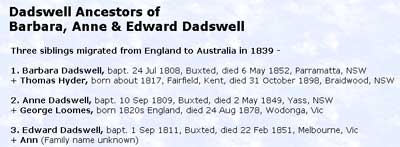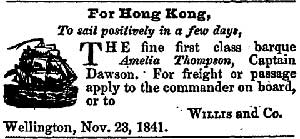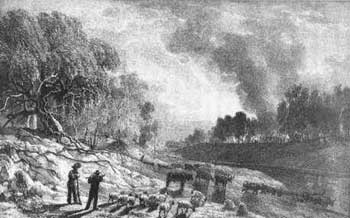|
Australia regularly faces bushfire seasons and at such times thoughts may well turn to a Dadswell who lost his life after being severely burned in what was described at the time as one of Victoria's worst-ever bushfires since European settlement.
The death was all the more poignant as the victim was one of a family of three siblings who migrated from England to New South Wales in the late 1830s, but just over a decade later all three died within the space of three years.
The parents of the three are shown in the 1841 English census - William and Barbara (Colbran) Dadswell farmed at Buxted, Sussex, in the early 1800s, with the family living at Stone House.  All of their nine children were baptised at Buxted, including these 4th, 5th and 6th children: All of their nine children were baptised at Buxted, including these 4th, 5th and 6th children:
- Barbara
baptised 24 July 1808;
- Anne
bapt. 10 September 1809; and
- Edward
bapt. 1 September 1811.
Click on this family tree image to see
more details of the three and their Dadswell ancestors. It was these three who migrated to Australia. On 27 September 1839, Anne - aged 30 and described on shipping records as a "finishing governess" and Edward - aged 28 and listed as a farmhand - arrived at Sydney Cove aboard the 477-ton barque Amelia Thompson, a sailing ship that was being used extensively to ferry migrants from England to Australia and New Zealand.

Family stories suggest that Barbara, then aged about 31, was also aboard the same ship, although her name was not included in the passenger list of 208 emigrants. It is possible she was employed by a family travelling in cabin class, as servants aboard this ship were not named in the passenger list.
On this voyage, the ship had left England on 11 June, making the voyage in 108 days or about 3½ months.
Again according to the shipping records, Anne and Edward were assisted single migrants. At this time the Colonial Office in London was offering payments of £15 to encourage emigration. Anne Dadswell is recorded as receiving a grant of £18 to make the trip, while Edward was described as "industrious and well conducted" according to statements made by his English church wardens, Edward Coleraine and Thomas Alehome.

Edward's connections with the church at Buxted (probably St Margaret's, pictured at right) was to play a role in his life in Australia. Both he and Anne could write, according to the shipping records.
The known story of the lives of the three siblings following their arrival in Australia is sketchy.
Barbara Dadswell
When Barbara arrived in Sydney, presumably aboard the Amelia Thompson in 1839, she was around 31 years old.
Four years later, on 20 September 1843, a convict nearing the end of his 14 year sentence, Joseph Shirt, was given permission to marry 'Barbara Dodswell' (Dadswell). The permission notes Barbara arrived as a free woman on the Amelia Thompson. At the time of this permission, Joseph was 28, Barbara 35.
Joseph had been sentenced with two others on 13 August 1835 to 14 years, in Kingston, Canada and subsequently arrived in Australia aboard the Norfolk convict transport. He was given a conditional pardon in 1844 but it appears the planned marriage did not proceed.
Barbara probably remained close to Sydney during her Australian life. According to her sister's marriage certificate, Barbara was living at the farming community of Narrellan, NSW, about 60 kilometres (37 miles) from Sydney town in 1846. She was about 39 when she married on 22 February 1848 at Marsfield, near Ryde, also a rural centre at that time, about 15 kilometres (10 miles) from Sydney town.
Her husband was Thomas Hyder, who also arrived in NSW in 1839, sailing aboard the barque Cornwall which reached Sydney with 374 government-sponsored emigrants on 1 September 1839. Shipping records described him as a shepherd who could "read and write very little". His father Nathaniel Hyder (husband of Charlotte (Cooper) Hyder, of Fairfield, Kent), was also described as a shepherd.
Four year later (1852), Barbara and Thomas were living in Phillip Street in Parramatta, some 25 kilometres (15 miles) west of Sydney. At this time Barbara was only 43 but she died on 6 May 1852 and was buried in St John's Churchyard at Parramatta.
There appears to have been no children from the marriage but when Thomas himself died at Braidwood, NSW in 1898 at the age of 81 he was described as a labourer, with a 21-year-old son, Ezra Thomas Hyder, born at Braidwood to Thomas and Mary Ann (maiden name not known) in 1877.
Anne Dadswell
Anne Dadswell gave her age as 28 when she arrived at Sydney in 1839. At the time of her marriage to George Loomes (sometimes shown as 'Loome') at Narrellan, NSW in 1846 she would have been around 36. George was the son of John and Ann (Speechly) Loomes who were at that time farming at Bowning, near Yass, NSW.
Anne and George were living at Yass in 1848 when Anne had a child, also called George, who died as a day-old infant. Anne, aged 39, died the following year and was buried at Yass Cemetery on 4 May 1849. Her husband George remarried at Yass that same year, to Mary Anderson who appears to have arrived in Australia the previous year, as an assisted immigrant aboard the sailing ship Walmer Castle.
George and Mary Loomes remained at Yass close to other members of the Loomes family for several years but by 1856, when their third child was born, they were living at Wodonga, Victoria, where George had become a wheelwright.
Edward Dadswell
Edward appears to have married before he left England, to Ann (family name unknown). Registers show a daughter, Mary Jane Dadswell, baptised on 13 April 1830. No records of Edward's wife have been found but the 1841 English census shows a Mary Jane Dadswell, then aged 12, living with school mistress Hannah How at Uckfield and this may have been Edward's daughter. But no evidence has emerged to show that she or her mother migrated to Australia.
About 10 years after arriving in Sydney, Edward was still working on farms and had some sheep and bullocks of his own in the Yass district where he was a carrier. In 1851 he made the 600 kilometre (380 mile) trip to Melbourne with Yass friend John Smallwood and Smallwood's wife. They were travelling by bullock-hauled dray (a wooden wagon) and had almost made it to Melbourne when disaster struck.
The previous year had been one of exceptional heat and drought - newspapers reported that pastures had withered, creeks had dried and water holes had disappeared. As the summer progressed, the temperatures became oppressive and on the morning of 6 February 1851 a fierce northerly wind developed the strength of what some witnesses said was that of a tornado.

It wrapped much of Victoria in a vast sheet of flame. The air was darkened by smoke, forests were ablaze, and houses, farm buildings, stock, bridges and wildlife were destroyed by fire. An estimated 12 lives, one million sheep and thousands of cattle were lost.
At the time of the fires, Edward Dadswell, John Smallwood and Mrs Smallwood had reached the area of the Plenty River, only 20 kilometres (12 miles) short of their destination of Melbourne, but they found there was little to protect them from the ferocity of the fires. As The Argus (Melbourne) reported on 17 February 1851:
Sufferers from the Bush Fire
A carrier from Yass, named Edward Dodswell (sic), was brought into the hospital on Thursday last, whose burns are of a very serious nature, extending the whole length of his back and over the greater part of his chest. He was brought from the ranges near the Plenty River, where it appeared he had camped with his wife and a bushman in his company. The whole team of bullocks and the dray, &c., were burnt. The other man saved himself by running until he had gained some ground that had been previously burnt. Dodswell and his wife laid themselves down in a creek, which had but about six inches in depth of water, but fortunately it was running fast, and by turning themselves over in it for about six hours, they escaped with difficulty from being burnt to death. As it was, all their clothing was burnt off them, and he was injured as previously described.
A subsequent report, on 24 February 1851, reported Edward's death and made clear the woman was John Smallwood's wife. The Argus reported:
An inquest was held on Saturday last upon the body of Edward Dodswell, whose case was detailed in our issue of Monday last, who expired early on Saturday morning, the 22nd instant, in the Melbourne Hospital.
The evidence of John Smallwood, of Yass, was that on the 6th instant, the witness and his wife were in company with the deceased, encamped by the side of the Running Creek, in Plenty Ranges, that they had early that morning observed that the bush fire was near them, but thought that it would pass by at some distance from their position, in which they were deceived. Through a fruitless endeavour at saving their bullocks and horses, witness lost sight of his wife and the deceased, and was himself almost miraculously saved by a shift of the wind when nearly surrounded by the fire.
He could not find his companions again that day, but fell in with them the next morning at Mr Patten's premises. The deceased was severely burnt. Every assistance that could be expected was rendered to all of them, and Dr Ronald attended daily to the deceased, who, at his own request, was removed to Melbourne.
Mr James Stone, Resident Apothecary of the Melbourne Hospital deposed, that when the deceased was admitted into the hospital, he was suffering from severe burns on the back, shoulders, and chest, and was then delirious; that every attention had been paid to him, but he gradually sank under his injuries, and expired at about half past six of that morning (Saturday).
A certificate from Dr Turnbull was handed to the coroner, stating that Mrs Smallwood (the female previously alluded to, and who, from her great attention to the deceased, had been supposed to be his wife), was unable to attend the inquest.
The jury, after a brief consultation, returned a verdict, that the death of Edward Dodswell was caused by burns received on the 6th instant, by the great conflagration in the neighbourhood of the Plenty River.
Edward's will (NSW Probate Office, Series 1, No. 2243) was drawn up in Melbourne after his admission to hospital and not long before he died. It states -
This is the last will and testament of me, Edward Dadswell, carrier, Port Phillip, son of the late William Dadswell of the Parish of Bucksted (sic) in the County of Sussex England, dated this 12th day of February, Eighteen hundred and fifty one. Being perfectly sound of mind, I will and bequeath to my sister Barbary Dadswell now Mrs Thomas Hyder the whole of my sheep, half the increase and all the wool now in the care of William Brown, Gunning. I also bequeath to my sister Barbary Dadswell whatever money is coming to me for my last years wool. I also will and bequeath to my friend John Smallwood carrier the whole of my cattle in the District of Yass branded ED/D also bullocks and the remains of the dray and all my cloaths (sic) and in consideration the aforesaid John Smallwood will see my remains comfortably and respectably interred in the Burial Ground in the City of Melbourne, Port Phillip and moreover the said John Smallwood will also erect a stone over my grave to my memory.
Signed and witnessed this present 12th day of February 1851. Signed Edward Dadswell. Witnessed: Wm Hy Hornan, Benjm Hilton, William Graham.
The William Brown referred to in the will was, along with his brother Tom, well-known in Yass district. They had both lived at Buxted, Sussex, had migrated to Australia in 1838 (a year earlier than the Dadswell siblings), had farmed at Camden near Narrellan, and at this time were farming in the Yass area close to where Edward and Anne had lived. Tom was also known as a fiery preacher, and the common birthplace, church connection, and Narrellan and Yass farming association all suggests Edward would have known them over many years.
It is unclear where Edward was buried or if a stone was erected over his grave. At the time of his death, Melbourne's cemetery was on the site of what is now the Queen Victoria Market in the city's north but it was already almost fully used with little space for further graves. Edward may have been buried there and later interred at Melbourne General Cemetery which opened in 1853, but no record has been located at this time.
Further information
Family tree - ancestors of Barbara, Anne and Edward Dadswell
Family tree - siblings of Barbara, Anne and Edward Dadswell
- Information compiled February 2009, updated April 2010 Return to Family Stories Index Page
|



